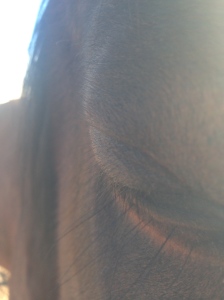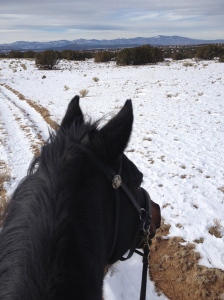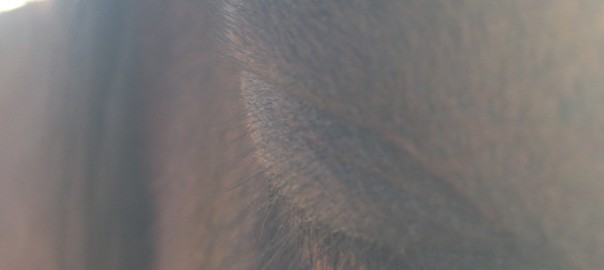With the cold weather and difficult footing, horses become very antsy and get “cabin fever.”
They really would like to run, but sometimes the footing is so treacherous we can’t let them out to just leap around joyfully without worrying about them twisting a leg.
There are several kinds of exercise for horses:
1) Exercise where they get to run around freely or graze freely.
2) Exercise that engages their minds
3) Exercise that engages bodies
4) Exercise that engages both body and mind.
When there isn’t safe footing for the horse to move around and kick up her heels, then we can go to 2) which will engage her mind. Horses also like to have interesting things to do and have a lot of curiosity about what we humans can come up with. To create an activity that doesn’t have a lot of goals attached to it and is fun will be much appreciated by your horse.
The reason to do any of this is so when I get on her back again, I don’t want to deal with a lot of wild and crazy behavior. I want the connection to be there from before we had the weather interruption in our schedules.
In order to accomplish this, I don’t just jump on. Some horses are fine with this, they never experience a ripple in their equanimity and allow you to just slide aboard with no problems, no wild and crazy pent-up energy. As a handler, it’s important to pay attention to the level of energy in the horse. With a horse you don’t know well, they can surprise you with calm behavior, then all of a sudden, this explosion of energy can burst forth, unexpectedly. It can happen even with those you do know well, but you might be able to anticipate better with the familiar horse.
With most horses, however, I want to check out their energy levels, and see if this is a body I want to get on. On slippery footing, I’m not going to get on, but I’m going to prepare the horse’s mind for when I will eventually get on in a few days when the ground dries out. This is a great opportunity to do some quiet liberty foundation work, or some online work, or a combination of the two.
 On one particularly cold, snowy day when it was impossible to do much, I worked with my young mare Jazzmine on some liberty and online exercises that were well suited to her. She likes to walk with me at liberty, which gives us an opportunity to build in stops and backing up, and turns. These exercises also engaged the body, but in a quiet way 3), so we were accomplishing 2), 3) and 4). She carries her head high, so we worked on releasing the poll, very gently, and then raising the head back up, with a suggestion, rather than pressure. We then progressed to the Whoa and Wait exercise, which suited her very well, and teaches ground tying without using tack (except a halter to guide her back to her standing spot). This is also good for teaching a horse to stand still at the mounting block. I could also work on this at the mounting block but didn’t want to add that into the equation that day, as it might be slippery. We also did some in-hand exercises for head lowering as well as stopping when asked at the end of a lead line. I want the whoa to be as light as doing it at liberty.
On one particularly cold, snowy day when it was impossible to do much, I worked with my young mare Jazzmine on some liberty and online exercises that were well suited to her. She likes to walk with me at liberty, which gives us an opportunity to build in stops and backing up, and turns. These exercises also engaged the body, but in a quiet way 3), so we were accomplishing 2), 3) and 4). She carries her head high, so we worked on releasing the poll, very gently, and then raising the head back up, with a suggestion, rather than pressure. We then progressed to the Whoa and Wait exercise, which suited her very well, and teaches ground tying without using tack (except a halter to guide her back to her standing spot). This is also good for teaching a horse to stand still at the mounting block. I could also work on this at the mounting block but didn’t want to add that into the equation that day, as it might be slippery. We also did some in-hand exercises for head lowering as well as stopping when asked at the end of a lead line. I want the whoa to be as light as doing it at liberty.
I also had to check in with myself to make sure this was a good exercise plan for me to try that day. It was good, because I needed to keep moving to keep warm, yet I had to negotiate difficult footing carefully and keep the lesson short so we didn’t freeze to death. I also make sure I’m not frustrated or bothered too much by the cold, so I don’t transfer my negative feelings to my horse. In the cold, I find I get very focused and try not to take on anything that might be too challenging for either of us.
These exercises are best attempted after the horse is well grounded in the Liberty Foundation Training that we offer at Horses at Liberty Foundation Training. They are also best tailored to the horse’s needs, which can vary from day to day. That’s why we want to always remain very flexible to changes in our horse’s energy, health, our own energy and the setting in which we are working.
In doing these types of exercises, we are also deepening our ongoing bond with our horse, so that we are well-connected on those few thinly sunlit days when we can at last slip into the saddle. This is the rich reward for the time well-spent on the ground, being together and learning together.
Have a very happy holiday and enjoy your horses, time off, and time by the warm fireplace with a hot drink.
Check out our video of Ground Exercises:
[youtube=http://www.youtube.com/watch?v=uC-v8Ji57_g&w=560&h=315]****
Services: Bodywork (Ortho-Bionomy for people, Equine Positional Release/Equine Ortho-Bionomy): private sessions (including Horse & Rider sessions), tutorials, phone consultations, distance healing communication and gift certificates
Liberty Training: clinics, mini-clinics, workshops, private and semi-private sessions, tutorials, consultations: by appointment: 505.501.2478 or emailing susansmith@orthohorse.info Winter Lessons – semi-private, private and small group sessions. Scheduling now. Contact me for details.
New on the schedule for 2014:
January 18, OrthoHorse Tutorial – Arrowhead Ranch, Santa Fe, Susan Smith, Advanced Registered Practitioner Ortho-Bionomy 9:30 a.m.-12:30 p.m. FULL. 1:30-4:30 p.m. OPEN.
February OrthoHorse Tutorial (Times TBA)
March 1-2 Horses at Liberty Foundation Training Weekend Clinic, DeLand, Florida. Contact Anne Daimler, tdaimler@cfl.rr.com (386-822-4564) or myself for registration and information. Space is limited. OrthoHorse Tutorial also offered before the clinic: February 28 (see flyers below). An afternoon Tutorial may be offered by popular demand.
April 5-6 Spirit Horse Ranch Liberty Foundations Clinic, Jones Oklahoma, Presented by trainers Ruella Yates and Susan Smith. Contact Ruella Yates ruella@libertyfoundations.com, (405-771-4274) or myself for registration and information. Space is limited.





Wonderful suggestions for winter activities to keep the bond and training in place when it’s dangerous to ride. The video is helpful to me, making it ‘real’ with Liberty Foundation exercises; thank you!
I have been following your blog Susan and enjoy and get a lot out of it. I hope to meet you at the clinic
April 5 & 6 in Oklahoma if all goes well. I am a trainer from Wichita, Ks and want to bring liberty training to my students here.
Thanks
Jan Laware
Hi, Jan, Thanks for writing. I do hope to meet you in Oklahoma in April! It would be great for you to introduce your students to liberty training. Be in touch, best, Susan